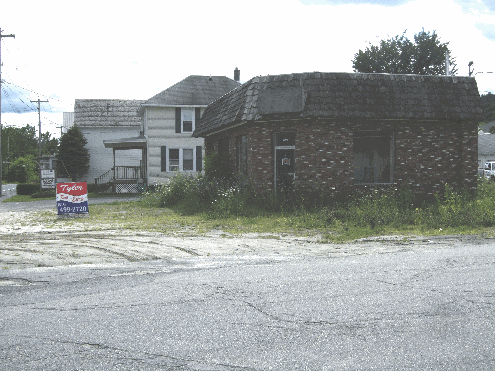
More local property will go on the market soon because people can’t afford their school tax bills. Out of control spending by the school board is causing property owners to sell their parcels.

If you are a property owner in Huletts, you just recently received your school tax bill for 2009-2010. I had two calls this week from people who have decided to put their homes up for sale because they can no longer afford the school taxes. One person told me; “I just can’t pay my school taxes. I have to sell.” I will continue to post pictures of businesses that have closed and cease to exist in Whitehall. The school board’s continued policy of overcharging, putting the funds in reserve accounts and spending on capital improvements, while enrollment is plummeting is a complete outrage. 
Whitehall’s steep decline is a testament to this flawed tax and spend policy.
What can be done?
1.) Have committed tax-cutters run for the school board and tell the school board members how you feel when you receive your tax bill. Ask questions. Why isn’t spending tied to enrollment? Why are businesses closing and for-sale signs appearing everywhere? You can be sure the board hears from the education establishment when setting the budget. They should hear from the taxpayers also. Here is the board of education that sets the budget. Only one person comes from Dresden.
2.) Understand the taxing policies of the school district. Know how the equalization rate effects our school taxes. What is this? By law, equalization rates are used to apportion taxes in taxing jurisdictions that cross municipal boundaries. These taxing jurisdictions are usually school districts.
The tax levy for the Whitehall school district is spread over the five towns it serves. Whitehall, Dresden and parts of Granville, Hampton and Fort Ann make up the district.
In a perfect world, all would pay the same tax rate based on their property being assessed at market value. However, because individual towns decide when their property will be reassessed, some towns are assessed at 100% of market value while others are not. NY state thus sets an “equalization rate” to apportion taxes equally among towns with different methods of calculating their assessment rolls.
The total tax levy for the district this year is $4,829,164.
This is where it gets a bit complicated and we need to put our thinking caps on.
Dresden has a low equalization rate of 45.53 % because we have not done a reassessment for a long time. So while the Dresden tax roll shows that Dresden has $129,001,445 in taxable property, NY State after applying the equalization rate calculates that the total assessed value of Dresden property is $283,332,846. Dresden thus pays $2,713,201 of the tax levy or 56.1% of the Whitehall school budget.
Whitehall’s equalization rate is 100% because they reassessed the town recently and went to 100% valuation. Their taxable property is carried at $196,081,028 and they pay $1,875,903 of the tax levy or 38.8% of the Whitehall school budget.
Hampton also has an equalization rate of 100% but their total assed value for the property within the district is only $23,410,183. Thus they only pay $223,724 or 4.6% of the Whitehall school budget.
Fort Ann has an equalization rate of 100% but little property served by the school distinct. Assessed property is $2,166,122 for a tax levy share of $20,724 or 0.4% of the Whitehall school budget.
Granville has an equalization rate of 77.51 % but has relatively little property within the district. The taxable assessed value of their property is $678,200 so Granville pays only $8,379 of the tax levy or 0.1% of the Whitehall school budget.
Should Dresden reassess and go to 100% of full value bringing our equalization rate in line with Whitehall, Fort Ann & Hampton? Only if you believe the town-wide assessment is too high and your assessed value is too high. How can you figure this out?
On your tax bill there is a column marked “Taxable Value or Units”, take that number and divide it by .4553 (Dresden’s equalization rate) and that is what NY state considers the full or fair market value of your property.
Taxable Value or Units on Tax Bill / .4553 = what NY says your property is worth.
If you think that this value is higher than what you would sell your property for, you would probably want your property to be reassessed.
If you think that this value is lower than what you would sell for, you probably don’t want your property to be reassessed.
I am not advocating for or against reassessment at this time but I want people to understand the issues involved. Because Whitehall is a town in significant decline and Dresden is not, this imbalance will most likely continue. We need to consider strategies that will work to lower taxes for all.
If the Town of Dresden was to reassess and the new town-wide total came in at an amount above the adjusted total of $283,332,846 that NY state says our property is worth (as adjusted by the equalization rate) we would pay an even higher share of the Whitehall school tax budget.
If the Town of Dresden was to reassess and the new town-wide total came in at an amount less than the adjusted total of $283,332,846 that NY state says our property is worth (as adjusted by the equalization rate) we would pay a lower percentage.
At its core, this issue is one of overspending by the Whitehall school board, the assessed value of property is only a way of spreading the taxes around.
I’d like everyone to try this calculation and give me your feedback. The bottom line is that in return for paying 58.1% of the school budget, Dresden gets very little in return. When you have one town paying this large a share with practically no representation, and a school board hell bent on destroying their own community through poor tax and spend policies, you have the situation we are all in today.
Sadly more people will end up selling because of the short-sighted policies of the Whitehall school district. That is the real tragedy.
